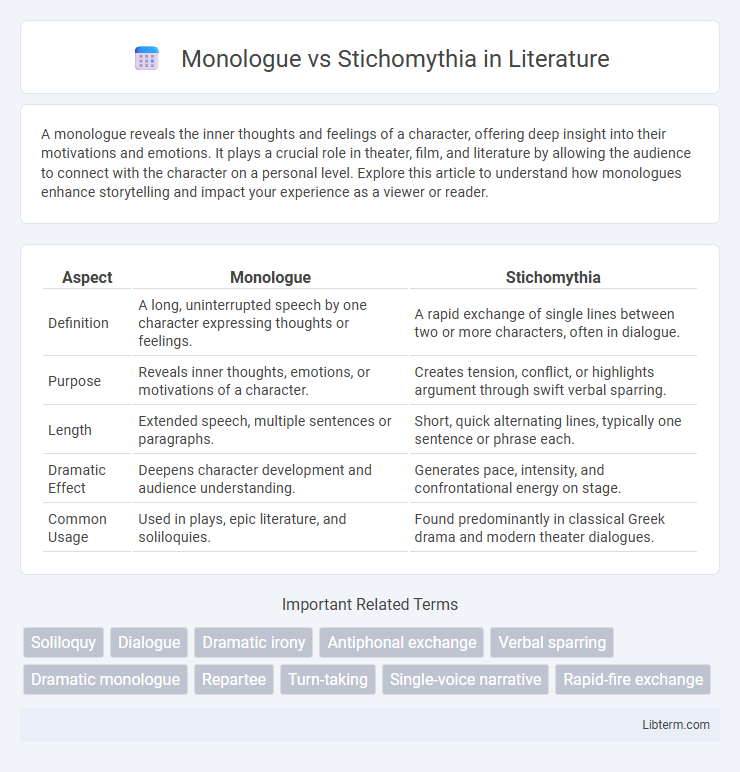A monologue reveals the inner thoughts and feelings of a character, offering deep insight into their motivations and emotions. It plays a crucial role in theater, film, and literature by allowing the audience to connect with the character on a personal level. Explore this article to understand how monologues enhance storytelling and impact your experience as a viewer or reader.
Table of Comparison
| Aspect | Monologue | Stichomythia |
|---|---|---|
| Definition | A long, uninterrupted speech by one character expressing thoughts or feelings. | A rapid exchange of single lines between two or more characters, often in dialogue. |
| Purpose | Reveals inner thoughts, emotions, or motivations of a character. | Creates tension, conflict, or highlights argument through swift verbal sparring. |
| Length | Extended speech, multiple sentences or paragraphs. | Short, quick alternating lines, typically one sentence or phrase each. |
| Dramatic Effect | Deepens character development and audience understanding. | Generates pace, intensity, and confrontational energy on stage. |
| Common Usage | Used in plays, epic literature, and soliloquies. | Found predominantly in classical Greek drama and modern theater dialogues. |
Understanding Monologue and Stichomythia
Monologue is a dramatic device where a single character delivers an extended speech revealing inner thoughts, emotions, or important plot details, often allowing for deep character exploration. Stichomythia involves rapid, alternating dialogue between two characters, creating tension and dynamic verbal exchanges that highlight conflict or differing viewpoints. Understanding these techniques enhances appreciation of narrative pacing and the emotional intensity within a play or screenplay.
Defining Monologue: Key Features
Monologue is a dramatic speech delivered by a single character, expressing their thoughts or emotions aloud without interruption, often revealing inner conflicts or advancing the plot. It features extended dialogue, allowing deep character exploration through uninterrupted, continuous speech that can range from reflective soliloquies to persuasive rhetoric. This distinguishes monologue from stichomythia, which involves rapid, alternating one-liners exchanged between two or more characters to create dramatic tension.
Defining Stichomythia: Distinctive Traits
Stichomythia is a dramatic dialogue technique characterized by rapid, alternating single lines spoken by characters, creating a highly rhythmic and confrontational exchange. Unlike monologues, which feature extended speech by one character expressing thoughts or emotions, stichomythia emphasizes quick repartee and verbal combat, heightening tension and conflict on stage. This distinctive trait enhances dramatic intensity and reveals character dynamics through sharp, concise verbal interplay.
Historical Origins of Monologue and Stichomythia
Monologue originated in ancient Greek theater as a dramatic device allowing a single character to express inner thoughts or narrate events directly to the audience, enhancing character development and plot exposition. Stichomythia, also rooted in classical Greek drama, evolved as a rapid exchange of single lines between two characters, intensifying conflict and emotional tension through rhythmic dialogue. Both techniques reflect the historical emphasis on oral performance and rhetorical skill in classical theatrical traditions.
Structural Differences in Dialogue Techniques
Monologue features a single speaker delivering extended speech, emphasizing introspection or narrative exposition, while Stichomythia involves rapid alternating lines between two characters, creating dynamic tension and conflict. Structurally, monologues are uninterrupted and allow for deep exploration of a character's thoughts, whereas stichomythia's brief, back-and-forth exchanges highlight immediate reactions and dramatic interaction. This contrast in dialogue techniques shapes the pacing and emotional intensity within theatrical and literary works.
Emotional Impact on the Audience
Monologues allow for deep emotional exploration, giving the audience intimate access to a character's inner thoughts and feelings, which fosters a strong emotional connection. Stichomythia, characterized by rapid-fire alternating dialogue, heightens tension and conflict, creating a dynamic emotional atmosphere that engages the audience through contrast and confrontation. The emotional impact of monologues is introspective and profound, while stichomythia generates immediate, often intense emotional exchanges that drive dramatic momentum.
Functions in Dramatic Storytelling
Monologue serves as a powerful tool in dramatic storytelling by revealing a character's inner thoughts, emotions, and motivations to the audience, often providing critical exposition or insight into the plot. Stichomythia, characterized by rapid, alternating dialogue between characters, functions to heighten tension, spotlight conflicts, and create dynamic exchanges that drive the narrative forward. Both techniques enhance character development and plot progression but differ in pacing and interaction, with monologues offering introspection and stichomythia emphasizing confrontation and immediacy.
Famous Examples in Classical Literature
Monologues in classical literature often showcase characters' inner thoughts and emotions, as seen in Hamlet's "To be or not to be" soliloquy in Shakespeare's *Hamlet*, revealing profound existential contemplation. Stichomythia, characterized by rapid alternating dialogue, is prominently featured in Sophocles' *Oedipus Rex*, where tense exchanges between characters heighten dramatic conflict and urgency. These distinct techniques serve to deepen character development and advance the plot through concentrated emotional or intellectual engagement.
Modern Usage in Theatre and Film
Monologue remains a powerful device in modern theatre and film for deep character exploration, often used in soliloquies or character-driven scenes to reveal inner thoughts and emotions. Stichomythia, characterized by rapid exchange of dialogue, is employed in contemporary dramatic works to create intense conflict or highlight verbal sparring between characters, enhancing tension and pacing. Modern screenwriting and playwriting utilize both techniques strategically to balance introspection with dynamic interaction, adapting classical forms to suit current narrative styles and audience engagement.
Choosing Between Monologue and Stichomythia
Choosing between monologue and stichomythia depends on the desired dramatic impact and narrative pacing. Monologues allow deep character introspection and elaborate storytelling, enhancing emotional connection and thematic development. Stichomythia, consisting of rapid alternating lines, intensifies conflict and heightens tension through dynamic, concise dialogue exchanges, making it ideal for scenes requiring heightened dramatic confrontation.
Monologue Infographic

 libterm.com
libterm.com